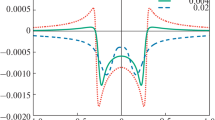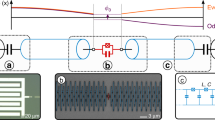Abstract
The Josephson effect occurs when the phases of the complex order parameter of two superconducting bodies separated by an insulating barrier become correlated.Prima facie, this is energetically favorable, since there is a finite coupling energy. However, when fluctuations of charge and phase are taken into account, one has to include the “cost” of these fluctuations in the energy balance. This becomes especially important in very small systems. We use the fluctuation-dissipation theorem to calculate the fluctuation energy and the associated free energy both when the junction is phase-correlated and when it is uncorrelated. In these calculations, we use the “resistively-shunted-junction” model to describe the junction. By comparing the excess free energy in the correlated state (over the uncorrelated one) with the Josephson coupling energy, we find a thermodynamic criterion for destruction of the Josephson characteristic of the junction. In the limiting case where the shunt resistance has a finite zero-temperature limit, we find a nearly universal resistance threshold. In another limit, where the resistance is taken to be the frequency-independent tunneling resistance of the Bogoliubov quasiparticles (in a “semiconductor” picture), our criterion reduces to that of Anderson when the temperatureT=0. We predict that for some junction parameters, the system can be reentrant, while for some other values, the transition temperature may be lowered.
Similar content being viewed by others
References
A. O. Caldeira and A. J. Leggett,Ann. Phys. (N.Y.)149, 374 (1983);153, 445 (E) (1984).
M. P. A. Fisher,Phys. Rev. Lett. 57, 885 (1986).
A. Schmid,Phys. Rev. Lett. 51, 1506 (1983).
F. Guinea, V. Hakim, and A. Muramatsu,Phys. Rev. Lett. 54, 263 (1985).
S. Chakravarty, G.-L. Ingold, S. Kivelson, and A. Luther,Phys. Rev. Lett. 56, 2303 (1986).
B. G. Orr, H. M. Jaeger, A. M. Goldman, and C. G. Kuper,Phys. Rev. Lett. 56, 378 (1986).
V. Ambegaokar, B. I. Halperin, and J. S. Langer,Phys. Rev. B 4, 2612 (1971).
P. W. Anderson, inLectures on the Many-Body Problem, Vol. 2, E. R. Caianiello, ed. (Academic Press, New York, 1964), p. 113.
B. Abeles,Phys. Rev. B 15, 2828 (1977).
B. Josephson,Rev. Mod. Phys. 36, 216 (1964).
D. E. McCumber,J. Appl. Phys. 39, 3113 (1968).
W. C. Stewart,Appl. Phys. Lett. 12, 277 (1968).
V. Ambegaokar and A. Barratoff,Phys. Rev. Lett. 10, 486 (1968).
H. B. Callen and T. A. Welton,Phys. Rev. 83, 34 (1951); L. D. Landau and E. M. Lifshitz,Statistical Physics (Pergamon, Oxford, 1969), § 126.
M. Abromowitz and I. A. Stegun,Handbook of Mathematical Functions, National Bureau of Standards, Applied Mathematics Series 55 (1964).
B. Mühlschlegel,Z. Phys. 155, 313 (1959).
I. Giaever,Phys. Rev. Lett. 5, 147, 464 (1960).
M. Razavy and A. Pimpale, Alberta preprint Thy-10-87.
Author information
Authors and Affiliations
Additional information
Sabbatical address: Physics Department, University of Alberta, Edmonton, Alberta, Canada.
Sabbatical address: Physics Department, University of California, Irvine, California.
Rights and permissions
About this article
Cite this article
Fibich, M., Kuper, C.G., Revzen, M. et al. Destruction of the Josephson effect by fluctuations. J Low Temp Phys 69, 459–472 (1987). https://doi.org/10.1007/BF00683333
Received:
Issue Date:
DOI: https://doi.org/10.1007/BF00683333




